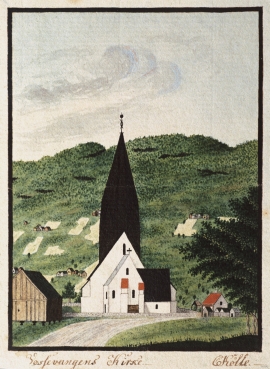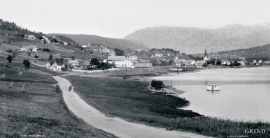Published: 25.02.2013 | Author: Nils Georg Brekke, Hans Emil Lidé
Vossevangen around 1890. (Axel Lindahl).
Vangskyrkja is a Gothic stone church with a large steeple in the west. The upper part of the steeple must also have been built in stone, but this was replaced by a wooden steeple around 1600. Through the centuries settling in the ground below the church has made it necessary to reinforce the walls with supporting outside pillars. It is these, together with the western steeple, that give the church in the Voss district its special character.
The church has been restored twice, first in 1875 and then in 1946-53. At this last restoration, the interior was returned to the time before 1875, characterised by 17th C interior. The altarpiece is composed of the middle part of a late Gothic altar cabinet that surrounds the painting “Lansestikket” (The Lance Stab) painted in 1642 by Elias Fiigenschoug from Ruben’s original painting in Antwerp. The pulpit from the 1640s is decorated in late Renaissance style around the picture of the Apostles, and the richly decorated separation wall in the chancel is from 1698. In the Middle Ages there was a lectorium – a scripture reading gallery – in front of the chancel arch, with a staircase inside the wall.





